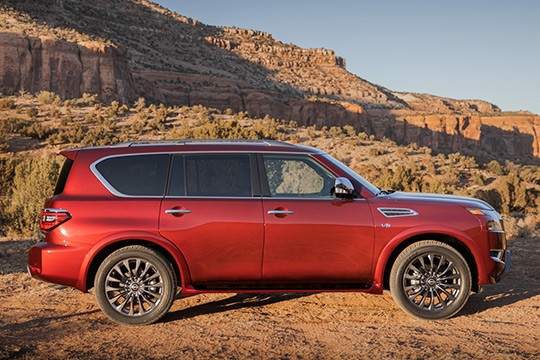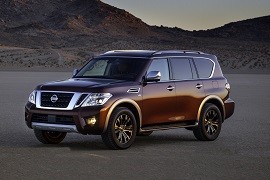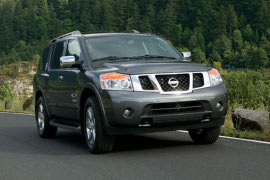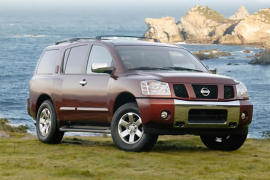NISSAN Armada Models/Series Timeline, Specifications & Photos
First production year: 2003
Engines: Gasoline
Body style: SUV (Sports Utility Vehicle)
The upgraded Armada was a full-size SUV with a rugged body-on-frame construction. For 2021, the Armada was highly redesigned, as the previous model had been around for quite some time and started to look dated.
The exterior design changes included a new grilled, a new hood, restyled front and rear bumpers, LED headlights and stoplights, as well as a new exterior color added to the list.
The Armada was fitted with a 5.6-liter V8 engine that cranked out around 400 hp and 394 pound-feet of torque. The thirsty powerplant was mated with a 7-speed automatic transmission.
Depending on the market, the Armada could be equipped with either a two-wheel drive or a four-wheel-drive system. Canada only offered the four-wheel-drive system as standard.
The full-size SUV weighed around 2.7 tons, however, the 5.6-liter engine handled it really well, with a quick acceleration response. Considering its weight and the size, it’s easy to say that the fuel consumption was no synonym to economy.
Practicality was one of the Armada’s strongest points, as it offered huge space inside. The large SUV could accommodate up to 8 passengers, unless the 2nd row was chosen with captain chairs, which allowed only 7 passengers.
The 3rd row of seats was mostly designed for children, as adults would have felt a little uncomfortable on longer journeys. The 3rd row folded flat to increase the cargo area to around 1400 liters, however, even with the 3rd row up, the Armada still offered more than enough space.
Designed for larger families, the Armada was a safe car, being equipped with the latest safety features available.
The second generation of the Nissan Armada was unveiled at the 2016 Chicago Auto Show. It was based on the global platform used for the Nissan Navara/Frontier.
The 2016 Armada was based on one of the most known Nissan's model, the Patrol. While it wasn't sold in the U.S., the Patrol was known in Europe, Australia, Russia, and Asian countries. With the second generation, the Armada was kept as a full-size family SUV, but with the rugged backbone offered by the Patrol Y62 model and shares the same chassis with the Infiniti QX80.
It is almost impossible to hide the Patrol Y62 roots on the Armada. The big grille, the headlights, and pretty much the entire vehicle was the same. The vents on the front fenders looked more appropriate for a sports car than on a rugged SUV, but it worked.
Inside, the Armada was available with standard eight seats, or seven with captain's chairs for the middle row. The interior featured an 8” touch-screen infotainment unit and a 13 Bose speaker audio system. Other standard amenities were the keyless entry and start, dual-zone climate control, and USB ports. The higher trim levels were equipped with front heated and ventilated seats, and heated second row.
For the drivetrain, the Armada was available with only one option: a 5.6-liter V8 unit mated to a 7-speed automatic transmission. It was taken from the Mercedes-Benz due to an engineering agreement and it was also used on the Nissan Navara/Frontier. Worth mentioning that the Navara had the Y61 rear axle system, with coil-springs. And that was used on the Armada, as well.
Nissan introduced an upgraded version for the Armada SUV in 2008 and gave it a bolder stance and improved engines.
Even though the world financial crisis had already started to bite the automotive sector, Nissan decided to improve its biggest SUV on the market, the Armada. Thus, it tried to keep the sales higher even when the rest of the automakers struggled to survive. Their strategy worked, and the big SUV survived until 2016, when it was replaced by a new generation.
Nissan understood that subtle changes wouldn't attract too many customers to its showrooms, so it changed the front fascia by adding a chromed trim on the grille. In addition, the lower side of the bumper got a different styling, with an A-shaped air intake. Yet, just like its predecessor, it featured a pair of round fog lamps placed on the outer side of the bumper. On the profile, the car featured two-piece body-color side moldings with chrome treatment.
Inside, the Nissan improved the eight-seat cabin and provided a new infotainment system fitted with a 9.3 GB hard drive for music. In addition, the DVD player featured a roof-mounted display for the second and third rows of seats. Moreover, the 11 speakers Bose sound system transformed the large cabin into a concert hall. The second and third rows of seats could have been folded or removed to expand the trunk space.
Under the hood, Nissan placed an upgraded version of its 5.6-liter V8 gasoline engine that provided 12 HP more than its predecessor. The automaker offered the big SUV with either a rear or all-wheel drive system.
Nissan introduced the 2004 Armada at the 2003 New York Auto Show and was part of the revival plan managed by the former top exec from Renault-Nissan Alliance, Carlos Ghosn.
Built on the same platform as the Titan pickup truck, the Armada aimed at those customers who needed a big and tough SUV able to pull a boat or a trailer effortlessly. In addition, it provided plenty of off-road performances, so it didn't get scared by some dirt, mud, or deep snow.
With a design that put emphasis on ruggedness and power, the Armada's front fascia sported big headlights that flanked the body-colored grille. The bumper featured an opening either for additional cooling or to pass a winch through it. From its sides, the two-box-shaped vehicle featured flared fenders and a tall cabin. But the automaker's design team created an unusual shape for the rear doors, with the upper side slightly sloped-down and masked door handles on the tilted C-pillars.
Inside, the Armada could offer up to seven seats on three rows but also offered an option for two captain seats in the middle row, separated by an additional storage compartment. Thanks to its body-on-frame construction, the full-size SUV provided a flat floor and enough room for all passengers. However, passengers had less shoulder room in the flat-folding third row of seats. For the driver, the automaker provided an infotainment system with a 7" screen on top of the center stack.
Power came from a 5.6-liter V8 and offered a maximum towing capacity of 9,100 lbs (4,127 kg).



